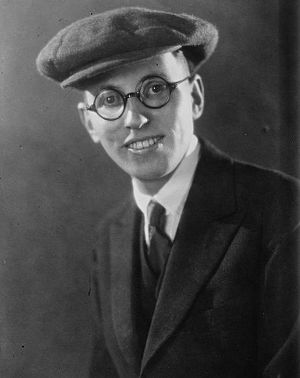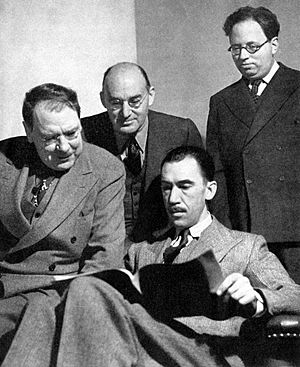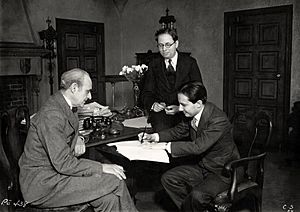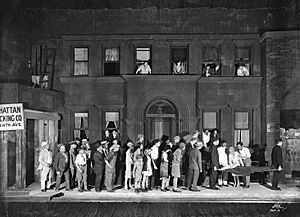Elmer Rice facts for kids
Quick facts for kids
Elmer Rice
|
|
|---|---|

Rice circa 1920
|
|
| Born | Elmer Leopold Reizenstein September 28, 1892 New York City, US |
| Died | May 8, 1967 (aged 74) Southampton, Hampshire, England |
| Occupation | Playwright |
| Education | New York Law School |
| Notable awards | Pulitzer Prize for Drama (1929) |
| Spouse | Betty Field (1942-1956) Hazel Levy (1915-1942) |
Elmer Rice (born Elmer Leopold Reizenstein, 1892–1967) was a famous American playwright. He wrote many plays, but he is most known for The Adding Machine (1923) and Street Scene (1929). Street Scene even won a special award called the Pulitzer Prize.
Contents
Elmer Rice's Early Life and Education
Elmer Rice was born Elmer Leopold Reizenstein in New York City. His grandfather was a political activist who moved to the United States. He lived with Rice's family and became very close to Elmer. His grandfather's ideas about freedom and peace influenced Elmer greatly.
Elmer loved to read when he was young, even though his family sometimes worried about it. He later said that joining the library was one of the most helpful things he ever did.
Because his father became ill, Elmer had to help support his family. He left high school early and worked different jobs. But he studied on his own and passed the exams to get into law school. Even though he didn't really like studying law, he graduated from New York Law School in 1912. He worked as a lawyer for only two years. His time in a law office later gave him ideas for plays, especially Counsellor-at-Law (1931). He became known for writing exciting courtroom dramas.
Elmer Rice's Career as a Playwright
After leaving law, Elmer Rice decided to become a full-time writer. This was a great choice!
First Play Success: On Trial
His very first play, On Trial (1914), was a big hit. It was a mystery about a murder and played for a whole year in New York. This play was special because it told the story backward, starting from the end and going to the beginning. On Trial was performed all over the world, and Elmer Rice earned a lot of money from it. It was even made into a movie three times!
Exploring New Ideas in Theatre
Rice was also very interested in political and social issues. He believed in socialism, a way of thinking about society where everyone is equal. He spent time in Greenwich Village, a part of New York City known for its artists and thinkers. He became friends with many writers and activists who cared about society.
In 1923, Rice surprised audiences with his play The Adding Machine. He wrote it in just 17 days! This play was a satire, which means it used humor to criticize how life was becoming too controlled by machines. It tells the story of Mr. Zero, a dull bookkeeper who gets replaced by an adding machine. He gets angry and murders his boss. After his trial, he goes to the afterlife but still faces similar problems. Critics loved it, calling it a very original and smart play about modern society. Even though it was praised, the play didn't make much money for Rice.
A Prolific Writer and Director
Elmer Rice was a very busy writer. He wrote many plays over the next few years. He also became interested in producing and directing his own plays. In the 1930s, he even bought a famous Broadway theatre, the Belasco Theatre.
His next big success was Street Scene (1929). This play won the Pulitzer Prize for Drama. It showed a very realistic picture of life in a busy New York City neighborhood. The play had fifty characters, making it feel like real life happening on stage. Many producers thought it would be too hard to stage, but Rice directed it himself and proved them wrong.
In the 1930s, Rice wrote other plays like The Left Bank (1931), a comedy about Americans in Paris, and Counsellor-at-Law (1931), which showed a realistic view of the legal world. He also wrote two novels and worked in Hollywood writing screenplays.
Rice was very passionate about his play We, the People (1933). It was about a working-class family struggling during the Great Depression. He wanted to show how ordinary people were affected by hard times.
Later Career and Activism

In 1937, Rice helped start the Playwrights' Company with other famous writers. One of his most successful later plays was Dream Girl (1945), a fantasy about a girl who finds romance in real life. His last play was Cue for Passion (1958).
Elmer Rice was also a strong voice for his beliefs. He was active in groups like the American Civil Liberties Union, which works to protect people's rights. He was the first director of the New York office of the Federal Theatre Project, a government program that supported theatre. However, he resigned in 1936 to protest when the government tried to censor a play. He strongly believed in free speech and spoke out against efforts to control artistic expression. He also spoke out against McCarthyism in the 1950s, a time when people were unfairly accused of being disloyal to the country.
Even with all his success, Elmer Rice sometimes felt he hadn't achieved his biggest goals as a writer. He wanted to do more experimental plays, like The Sidewalks of New York (1925), which had no words. But Broadway wasn't always ready for such new ideas, which was frustrating for him.
Elmer Rice's Personal Life
Elmer Rice was married twice. He married Hazel Levy in 1915 and they had two children, Margaret and Robert. After they divorced in 1942, he married actress Betty Field. They had three children: John, Judy, and Paul. They divorced in 1956.
Even though he came from a family not involved in the arts, Rice loved art. He collected works by famous artists like Picasso and Modigliani. He often visited museums in New York and enjoyed seeing art from around the world. He was also good friends with the Japanese-American painter Yasuo Kuniyoshi.
Elmer Rice lived for many years in Stamford, Connecticut. He passed away in Southampton, England, in 1967 at the age of 74. People remembered him as a respected figure in theatre. Brooks Atkinson, a theatre historian, described Rice as a thoughtful man who was very clear-headed when it came to important social issues.
Elmer Rice's Works
Stage Productions
Here are some of the plays Elmer Rice wrote and sometimes directed:
- On Trial (1914)
- The Adding Machine (1923)
- Close Harmony (with Dorothy Parker, 1924)
- Street Scene (1929)
- The Left Bank (1931)
- Counsellor-at-Law (1931)
- We, the People (1933)
- Judgment Day (1934)
- Dream Girl (1946)
- Cue for Passion (1959)
Novels
Elmer Rice also wrote novels:
- On Trial (1915, based on his play)
- A Voyage to Purilia (1930)
- Imperial City (1937)
- The Show Must Go On (1949)
Non-fiction Books
He wrote books about theatre and his own life:
- The Living Theatre (1959)
- Minority Report (1964)
Film Adaptations of His Plays
Many of Elmer Rice's plays were made into movies:
- 1917: On Trial
- 1922: For the Defense
- 1924: It Is the Law
- 1931: Street Scene
- 1933: Counsellor at Law
- 1948: Dream Girl
- 1969: The Adding Machine
Images for kids
-
WPA poster for Counsellor at Law, California, 1938.
See also
 In Spanish: Elmer Rice para niños
In Spanish: Elmer Rice para niños




